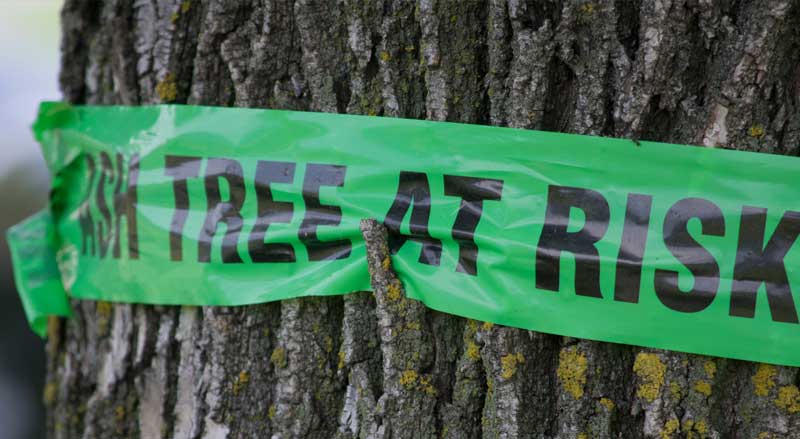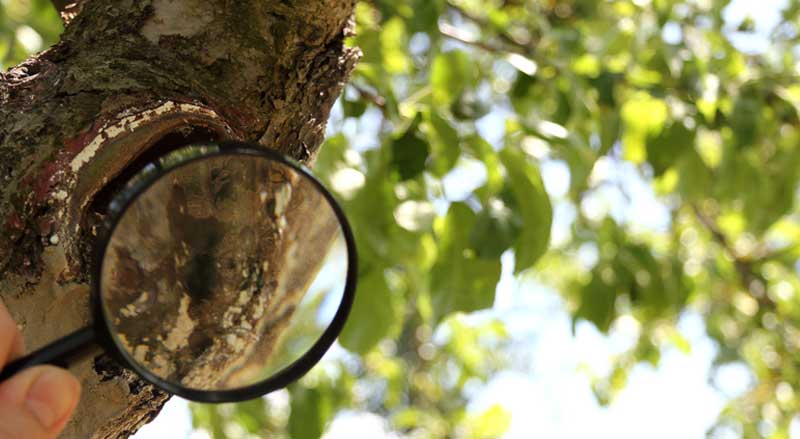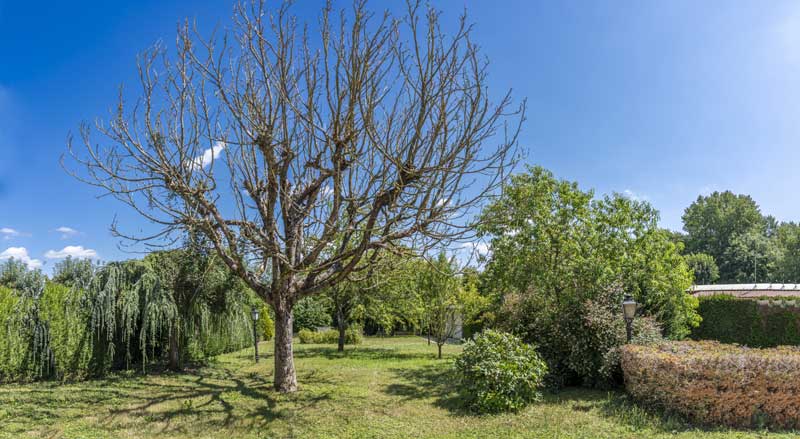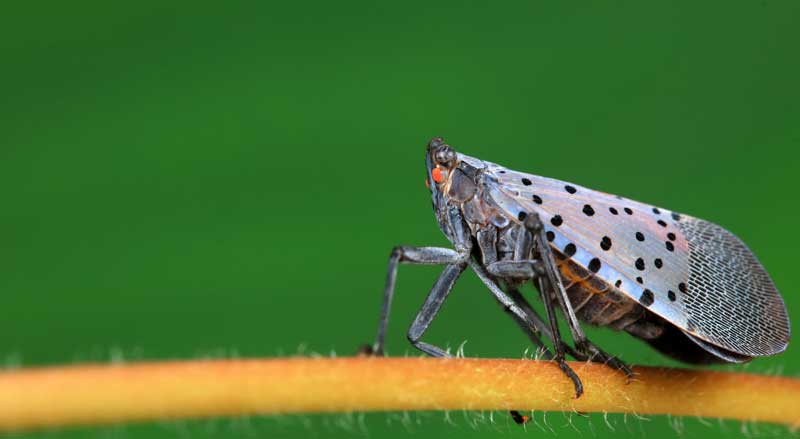There are many common tree diseases in New Jersey that can take over your yard in as little as one season. Early detection is the most important part of dealing with issues that arise.
There are preventative measures that can be taken to alleviate the unnecessary spread of many fungi, bacteria, and other pests.
Some of these common tree diseases may be germinating in your backyard. Take action as soon as possible before they have a chance to damage your property’s valuable assets.
Anthracnose
The name anthracnose is a collective term for several common fungal diseases that affect shade trees.
It can destroy the tips of young twigs and leaves and cause defoliation. Anthracnose spreads easily and thrives in warm, moist conditions.
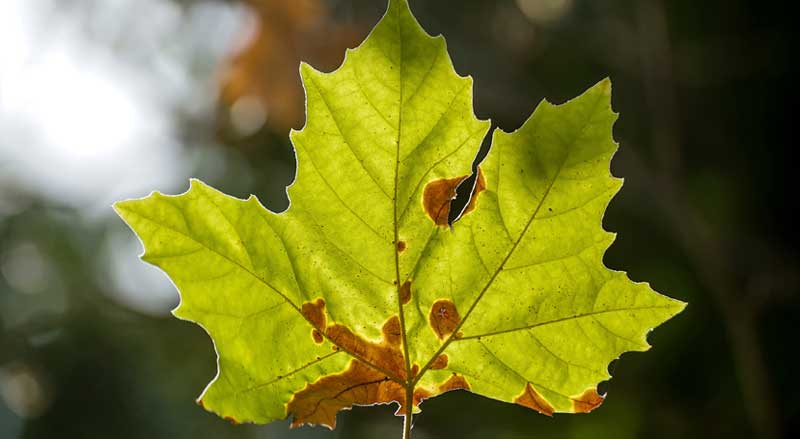
What to Look for
Dead spots on leaves, irregular leaf growth and a loss of foliage earlier than expected are all signs that your tree is suffering from anthracnose.
Disease Prevention and Removal
This disease thrives in a damp location. So, if air can move through your trees with ease, they will be less likely to contract anthracnose in your yard. Always use best practices for planting trees on your landscape.
Read about how to plant productive trees for your landscape and learn how proper tree spacing helps air circulation.
Early detection and treatment of anthracnose prevents necessary tree removal.
If this fungus affects a tree, prune away dead branches. Remove and carefully destroy infected leaves.
Inject fungicides into the tee trunk or branches. Treat soil as well.
A tree overtaken by the fungi should be completely removed from your property before the disease spreads to other plants.
Trees Affected
Sycamore, elm, hickory, walnut, ash, oak, maple, and dogwood
Seiridium Cranker
This fungal disease is usually brought on by stress from the weather, such as a drought or cold injury. This fungus attacks the vascular system of the tree and spreads quickly. This can devastate trees that are planted in a row or cluster as a greenscreen for privacy.
What to Look for
Seiridium Cranker symptoms appear in early spring but can occur at any time during the year.
As the disease progresses, the foliage fades from green to light yellow to a reddish-brown.
Obvious dead brown branches and foliage will appear throughout different areas of the tree. The branch or possibly trunk of the tree may also show a swollen area called a cranker that oozes sap and allows more fungi to enter your tree.
Disease Prevention and Removal
Pruning away infected areas and removing the contaminated branches and leaves from the tree and surrounding area are key to keeping this disease from spreading.
You should sterilize the blades of the pruning instrument after each cut.
Fertilizing, mulching, soil management and watering your tree regularly will aid in keeping this fungal disease away from your trees all together. Avoid bark wounds when possible.
Trees Affected
Leyland cypress, Italian cypress, Monterey cypress, arborvitae, and Juniper
Emerald Ash Borer
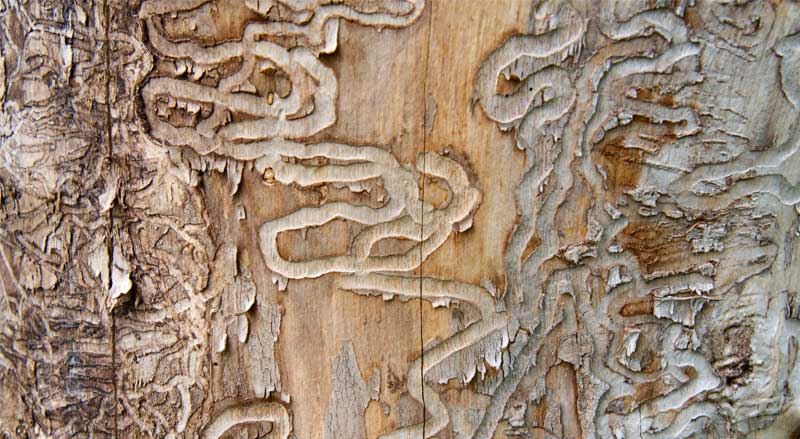
The emerald ash borer (EAB) is a beetle whose larval stage disrupts the tree’s ability to carry water and nutrients throughout its system.
The emerald ash borer has killed many ash trees throughout the Northern NJ area in the last few years. It was first discovered in New Jersey in 2014, and by 2022 has spread throughout all NJ counties.
Ninety-nine percent of ash trees infested with EAB usually die after 3-4 years.
What to Look for
Signs of EAB infestation are very subtle at first. You may notice a few dead limbs in the tree’s crown. Eventually, there’s a thinning of the overall canopy that travels downward. You may seek bark flecking in the higher branches.
Infected ash trees show devastation after our 2022 harsh NJ winter. Tree trunks and limbs have missing bark. Piles of bark flakes gather beneath the trees. This is a symptom of advanced infestation. However, woodpeckers are responsible for the missing bark; they remove the bark in their search for EAB larvae.
Eventually you’ll see foliage dying in the tree’s higher branches and cracks in the tree’s bark.
Disease Prevention and Removal
The important news is that you can prevent emerald ash borer (EAB) infestation. An insecticide injection into the trunk will protect your tree from EAB infestation for two seasons—if done before major damage occurs.
You can also add insecticide to the soil at the base of the tree.
Treatment works best in trees smaller than 50 inches in circumference.
A tree with a lot of removed bark can no longer be treated. Remove it promptly.
Trees Affected
Ash trees
Needle Cast
Needle cast is a fungal disease.
Needle cast will take time, possibly multiple seasons, to completely take hold of a tree, but once the first signs of the disease show on your tree it will become a large eyesore on your property.
It’s very important to take act quickly once the first signs are noticed.
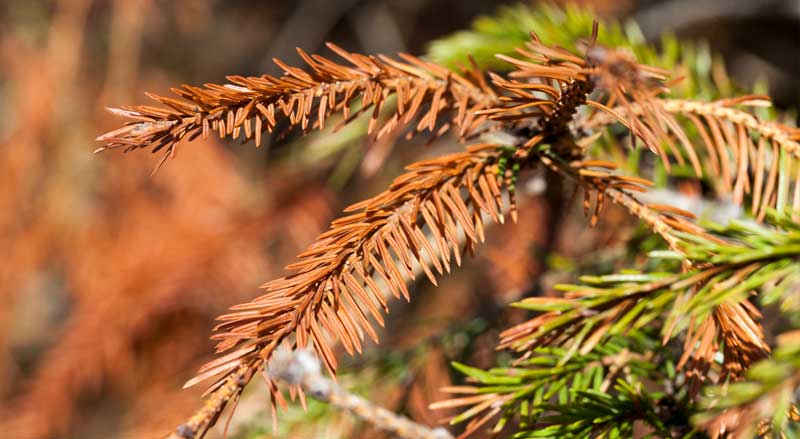
What to Look for
In the summer, affected needles turn yellow.
Signs of Needle Cast continue in fall and typically start at the bottom of the tree with the presence of brown or purplish needles. The fullness of your tree will also decrease, especially near the bottom, and your tree even has the potential to lose all of its needles.
If you examine fallen needles with a magnifying lens, you’ll see rows of black dots—fungal spores.
Disease Prevention and Removal
Needle cast often affects trees that are stressed because of drought or poor planting conditions.
Needles infected by this fungus cannot be saved and will eventually fall off. So, focus on protecting new needles from the fungus.
Remove dead and dying branches from your tree.
Then begin treatment with the proper fungicide—usually for 2-3 consecutive years—in the spring or early summer. By this time, new needles have reached half of their eventual full length.
Continue to fertilize the tree’s soil and mulch around the tree to provide moisture and hold in nutrients. During a drought, deep water the roots.
Trees Affected
Spruce—especially blue spruce
Armillaria Root Rot
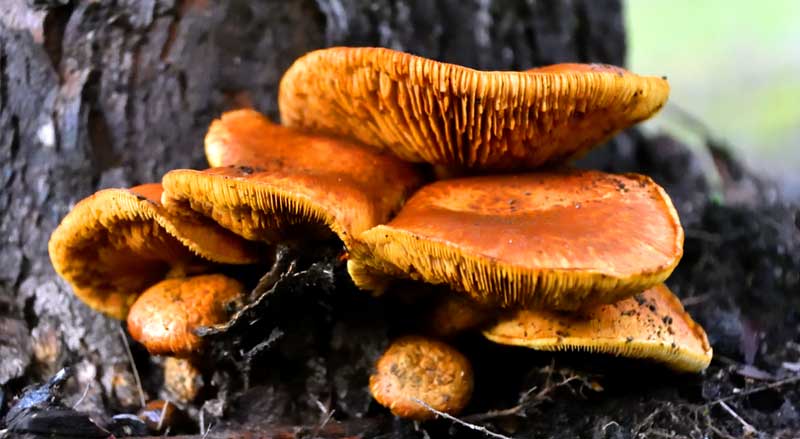
Armillaria root rot is a fungus that starts in old and rotten oak and maple tree stumps and dead roots. The fungus is often called oak root fungus even though it is not specific to oak trees.
It can easily spread to other nearby trees and plants because it is able to penetrate through a tree’s root system.
It can destroy entire groups of trees.
What to Look for
Tan-colored mushrooms growing at the base of your tree’s trunk or beneath its canopy are a major sign that your tree has a root rot fungal disease.
You may see reduced leaf growth, yellowing and browning of needles, and dying branches. There may be white resin at the base of the host tree. Creamy white fans of fungus may appear between the bark and root stem.
Disease Prevention and Removal
Root rot can be cured in trees, especially when the disease is in its early stages.
Drought enhances this disease and will heighten the pace of its ability to spread.
Water your trees regularly to ensure that drought cannot harm your trees.
Consider treating your soil with good fungus spores such a trichoderma which will eat away at the bad fungi.
Removal of a rotten tree stump is the best possible solution to preventing this disease from spreading.
Trees Affected
Christmas tree evergreens, oak, maple, almost any conifer. The only genera of trees that are resistant to armillaria are larch and birch.
Black Knot Disease
Black knot disease is a common fungal disease of ornamental trees.
Windborne spores spread the disease during the wet spring. They infect younger trees or wounded branches.
What to Look for
There are no visible symptoms early on; the fungus is growing inside the branch. Eventually, there is a slight swelling on newer areas of the tree.
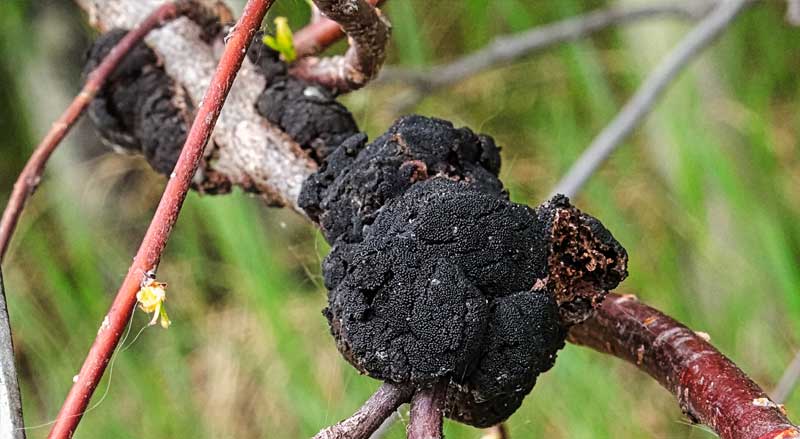
Eventually these growths become large, black, elongated swellings scattered throughout the tree. These “knots” or “galls” range in size from 1 to 6 inches. They are covered with velvety green spores.
When left untreated, knots increase in number. The infected branches stop growing leaves and may die.
Disease Prevention and Removal
Prune away all branches and stems that show signs of the disease. Dispose of these cuttings by burning or burying them away from the trees. Treat with fungicide.
Trees Affected
Plum and cherry trees
Dutch Elm Disease
Dutch elm disease is a quick spreading fungal disease that has killed many elm trees in New Jersey.
It grows in the tree’s sapwood, just beneath the bark. It is a vascular wilt disease. Water carries the fungus throughout the tree. Eventually the fungus blocks the water from traveling.
What to Look for
Leaves on one or more branches in the outer crown yellow, wilt, and turn brown. You will see fallen leaves during the spring and summer. Symptoms can begin at any time during the growing season.
Disease Prevention and Removal
You can save trees in the early stages of infection, but they will die if not treated early.
An important preventive measure is to prune all dead and dying branches in the fall to late winter.
Infected branches need to be removed. Also, inject the tree with a registered fungicide.
Beetle infestations can carry the fungus, so spray and prune properly to avoid this infestation.
Trees Affected
All elm varieties
Hawthorn Rust & Cedar-Apple Rust
Hawthorn rust and cedar-apple rust are two fungi that cause tree disfiguration. While they do not kill trees, they can do considerable and unrecoverable damage.
Windblown spores or insects spread the disease.
What to Look for
These two fungi cause leaf discoloration. Hawthorn rust causes yellow spots to appear on leaves. Foliage develops bright yellow spots and leaves fall prematurely. Yellow spots often have small black spots in the center. Fruit of the tree can also be affected.
Cedar-apple rust causes leaf spots that are originally yellow and then turn bright orange with an obvious red border.
If you eat apples from trees affected with cedar apple rust, there can be brown areas on the apple that are not harmful but can taste bitter.
Disease Prevention and Removal
There are several fungicides recommended for treatment.
Trees Affected
Hawthorn, juniper, apple, crabapple
Spotted Lanternfly
The spotted lanternfly is a pest that has become a common tree infestation in New Jersey. It was first found in the US in Pennsylvania in 2014. Since 2018, the insect has spread to New Jersey and other states.
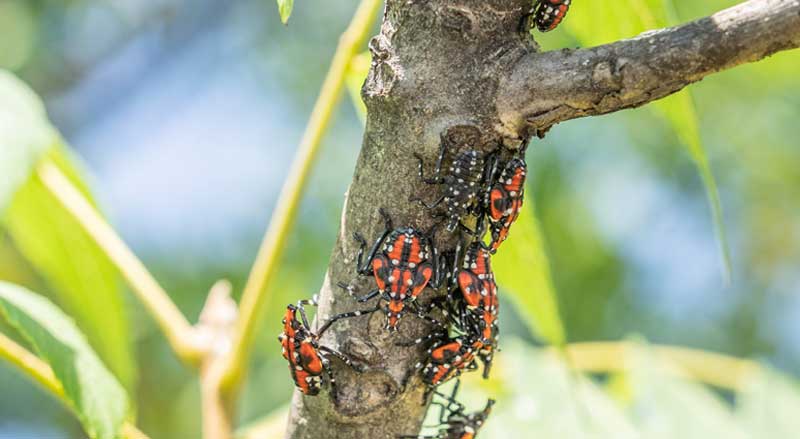
This pest measures about one inch. It is black with white spots, stripes, and yellow and red markings.
The insect has a piercing mouth that helps it feed on many fruit, ornamental, and woody trees and over 70 plant species.
It’s a threat to many agricultural crops, including grapes.
These insects cannot hurt humans or pets but are annoying when they swarm.
What to Look for
The tree of heaven, an invasive tree now found in NJ, is a preferred host for the spotted lanternfly egg. The eggs hatch between April and June. You will find eggs on many outdoor surfaces, including other trees and rocks.
Trees infested with spotted lanternflies experience dieback and leaf curling.
Disease Prevention and Removal
Sticky egg masses appear on trees or other outdoor items. Scrape the masses into a plastic bag and discard.
Spray white vinegar or neem oil on these insects to kill them on contact.
Install sticky bands and circle traps on tree trunks to catch spotted lanternfly nymphs.
Trees Affected
Tree-of-heaven, maple, birch, apple, plum, cherry, willow, poplar, oak, black walnut, tulip, birch, and other fruit, ornamental, and woody trees.
Oak Wilts Fungus
The oak wilts fungus, not yet found in NJ, has affected other mid-Atlantic states.
This devastating fungal tree disease circulates through the vascular systems of trees and can kill a tree in a matter of weeks.
What to Look for
Initial signs of oak wilt fungus are leaf dieback and defoliation.
An infected branch can have black or gray fungus just underneath the bark.
Leaf symptoms usually appear in the spring. They turn a dull green or bronze and then advance to yellow and brown.
Once tree limbs die off, the entire tree usually follows within a few months.
If you think you see this fungus on a tree in New Jersey, here’s how to collect it and send it in for analysis.
Disease Prevention and Removal
You can’t save infected trees, but nearby trees can be treated with a systemic fungicide that will suppress the bacteria. It’s important to treat trees within 30 feet of a positive infection since this fungus spreads through root grafts and insects.
Prune trees carefully, and not in the warm growing season.
Trees Affected
Red oaks and other oaks
Other blogs you may be interested in are:

